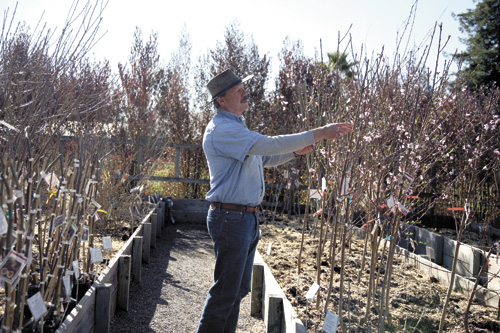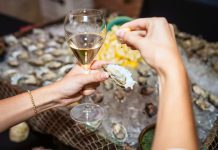by Lynda Hopkins
Staff Writer
Warm weather means buds are breaking and blossoms are blooming across the county. As gardeners gear up for spring, one opportunity is quickly passing them by — the opportunity to start or expand their backyard orchard.
“We’re at the end of the bare root season, and we’ve begun our canning. So the selection is still good, but getting more limited by the day,” said Michael Skurtun, owner of Healdsburg Nursery.
As the bare root fruit trees wake up from their winter slumbers, it becomes more challenging to transplant them.
“They’re dormant,” explained Scott McPhee, who has overseen the bare root selection at Harmony Farm Supply for eight years. “When they’re dormant, they can be transplanted with ease. Once they leaf out and flower, it’s more shocking to the plant, and there’s less chance of success.”
At Healdsburg Nursery, Michael Skurtun has developed a system that enables him to extend the life of his bare root trees. He pots them up in pulp pots, so that he can continue to sell the trees after they leaf out. The trees can be put in the ground at any time without shocking the plant: once planted, the tree’s roots are able to grow right through the pot.
“Pulp pots decompose when planted. We recommend slicing the bottoms and the sides in three or four places to expedite the decomposition process,” Skurtun said.
Rather than potting up all of their heritage bare root fruit trees, Harmony Farm Supply hosts an annual weather-dependent sale to help clear out most of their remaining stock — which, based upon the weather, should happen any day. Trees purchased prior to the sale come with a leaf-out guarantee, while the on-sale trees do not.
For those gardeners who are just considering their first fruit tree, experts recommend starting out with an apple or pear, or perhaps a plum.
“For the beginner, I recommend apples, plums, or pears,” Skurtun said. “Most stone fruits such as peaches and apricots have a shorter life span in this area due to the heavy clay soil and amount of rain that we get.”
McPhee agreed.
“Certainly an apple — you’re in great apples and pears country around here. Apples are probably the easiest,” McPhee said.
But choosing what type of fruit to start out with is only half the battle. Once you’ve settled on the fruit, you have to settle on a variety — and local nurseries are packed with interesting heirlooms as well as more common grocery store varieties.
“Golden russet is one of my favorites. It has skin like a russet potato. It’s very sweet, but with a bit of a tang to it. Not very pretty, but it’s a great apple,” McPhee said.
“I’d also really recommend Sierra Beauty. We’re sold out in bare root but I have some in pots. Again, a really good local apple.”
McPhee noted that plums are also a good introductory fruit tree, and recommended the Mariposa, which sports a beautiful maroon and green skin around a bright maroon flesh.
And if you’re feeling adventurous, you might try a fruit with a name that many people associate more with candy than an orchard.
“It’s a Jujube,” said McPhee. “When they’re fresh, they’re crunchy like an apple, and when they’re dried, they’re very much like a date. They like a little bit of heat, and they don’t need much in the way of water.”
Once you have selected your bare root fruit tree, you want to get it into the ground as soon as possible. And there are some steps to take to ensure that the tree has the best start in life.
“Plant them slightly mounded, slightly raised — approximately two inches. We recommend 1/3 soil amendment to 2/3 native soil. Once they grow beyond the hole, they’ll be well acclimated to the native soil,” Skurtun said.
Resist the temptation to leave the soil around the tree light and fluffy.
“When you amend your soil, make sure you pack it well by hand on the sides and underneath, because otherwise the rain will pack it and it will sink. Then, once it’s planted, add light mulching one to two inches thick, being careful not to bury the trunk,” Skurtun said.
But once the tree is planted there are other dangers to avoid: splits and blisters caused by sun, which can allow insects to invade.
“On young fruit trees, for the first two to three years we recommend white washing them which will minimize any sunburn on the young tender trunks. There’s a whitewash specifically for trunks,” Skurtun said.
And with fruit trees, you also have to be cruel to be kind.
“We also recommend pruning new fruit trees significantly, usually 50 percent or more, to encourage low branching so that the homeowner doesn’t have to get out a six foot ladder to pick a few peaches, so to speak. What I do personally, mine are the height of how tall I can reach up and prune without a ladder. You don’t need a 20-foot plum tree for a small family. We encourage people to keep them lower and squattier if they can,” Skurtun said.
And although you may be extremely excited for that first fruit off your brand new tree, it’s best to wait until at least the third year.
“We also recommend for the first two years minimum to pick off the fruit so the tree spends its energy on maturity, rather than fruit production. Enjoy the blossoms, but as you start to see the young fruit start to form, pluck it off if you have the heart to.”
By the third year, you should be able to enjoy the fruit. As the saying goes, the best time to plant a fruit tree was 20 years ago. The second best time is now.
Where to learn more: fruit tree resources
California Rare Fruit Growers, Redwood Empire Chapter:
www.crfg.org, 766-7102
CRFG hosts an annual scion exchange, as well as informative workshops, rare fruit tastings, and membership meetings.
Fruit Tube: Dave Wilson Nursery’s fruit tree videos
www.youtube.com/user/DaveWilson-Trees.
“Fruit Tube” has informative videos about pruning, planting, grafting and caring for backyard fruit trees.









